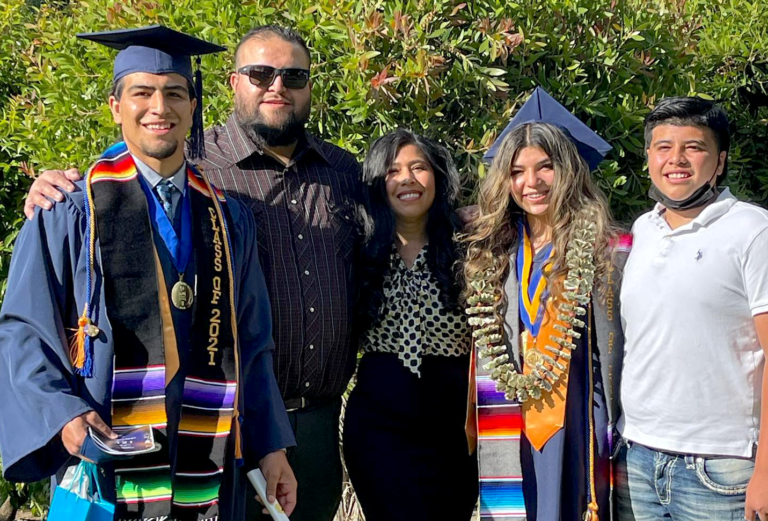Dual Enrollment Success Stories: Nataly Frias

Nataly Frias and family: parents Anthony and Sabrina, both CSU Stanislaus alumni, are counselors at Modesto Jr. College and Merced College respectively. Older brother Anthony Frias, II, (far left) also took dual enrollment courses and graduated from MC in the spring with Nataly. Younger brother Isaiah, a Turlock High junior, (far right) turned 16 this month and is also taking dual enrollment courses at Merced College.
Dual Enrollment: success stories underscore equity-driven strategy
Reducing disparities in student persistence and completion rates
BY TOM URIBES
CVHEC Communications/Media Coordinator
The Covid-19 pandemic of the past 18 months cast a shadow over joyous occasions like graduation events for Class of 2020 and 2021 high school and college students everywhere, but one narrative emerged repeatedly in the Central Valley that provided a spark of optimism for our region’s college attainment rates: dual enrollment success stories.
One of those stories is 18-year-old Nataly Frias, who, during her pandemic senior year at Turlock High School (2020-21), had taken enough Merced College courses online to earn two associate degrees in May, even before receiving her THS diploma in June.
Like other students around the country over the years, California students such as Nataly have taken college-level courses while still completing their high school degree thanks to various options such as concurrent or dual enrollment.
“Recent legislation has opened the gates for far more students to take advantage of dual enrollment,” said Saundra McGlothlin, CVHEC’s central regional coordinator and dual enrollment lead “The CVHEC region is committed to stay engaged in developing solutions to overcoming persistent barriers to equity.”
Born to teen parents who themselves worked hard and returned to college (Stanislaus State alums Anthony and Sabrina Frias who are now counselors at Modesto Jr. College and Merced College respectively), Nataly is now enrolled at Fresno State for a bachelor’s degree in Psychology but with her sights set on the Nursing Program.
“Just do it,” Nataly said in a media account about her success and the challenge of dual enrollment courses. “It’s a lot of hard work but you’ll feel so accomplished.”
The pandemic actually had a silver-lining in that she had more time during the quarantine to focus on schoolwork.
“I probably wouldn’t have graduated as early without the pandemic because it really helped give me so much time where I was only focused on my online courses,” said Nataly who said she comes from a “dual enrollment family.”
Her older brother Anthony also took dual enrollment courses when he attended Turlock High and graduated from Merced College with Nataly last spring but is now enrolled at Modesto Jr. College where he plays football. And younger brother Isaiah, a Turlock High junior, is currently taking dual enrollment courses thorough Merced College.
McGlothlin, who retired in 2017 as the vice president of Student Services for West Hills Community College – Coalinga, noted that not all students follow Nataly’s accelerated path of earning an associate degree while in high school. Many take just a few dual enrollment courses that help them get some college credit under their belt while providing a glimpse of the higher education academic curriculum.
“Most of dual enrollment students complete 12-24 units,” said McGlothlin. “This means — in addition to meeting graduation requirements — less money spent when working towards a degree in college, usually a semester or two free.”
See Nataly’s story in local news media accounts:
https://sacramento.cbslocal.com/2021/05/21/turlock-teen-graduates-high-school-college/
Background:
The Central Valley Higher Education Consortium has been playing an increasing role in furthering Dual Enrollment as an equity-driven strategy to reduce disparities in student persistence and completion rates, which is the essence of the CVHEC mission, including
the creation of a task force in 2019, the Central Valley Dual Enrollment for Equity and Prosperity (CVDEEP).
With over 60 education leaders from the CVHEC region, CVHEC’s Central Valley Dual Enrollment for Equity and Prosperity (CVDEEP) Task Force is identifying and establishing the best elements of a sustainable strategy for dual enrollment that is intentional and aligns with Guided Pathways.
Made up of representatives from Central Valley K-12 districts, colleges, and universities, the task force developed a collaborative regional accord on an equitable delivery of dual enrollment, culminating in a Central Valley Higher Education Consortium white paper in July 2020, “Dual Enrollment in the Central Valley.”
This consensus framework document is designed to assist the nine-county region in the advancement of dual enrollment by reviewing where it has been, identifying the bright spots, identifying challenges and working together to develop solutions.
CVHEC efforts focus on policy implementation and delivery of support to faculty and administrators working on these efforts. The work focuses on regional strategic scaling of Guided Pathways; math pathways; corequisite support (AB 705 and EO 110 implementation); California College Guidance Initiative; and dual enrollment as strategies for equity and degree attainment.
CVHEC will continue to highlight success stories like Nataly’s in its e-newsletter, and social media platforms. Also, a showcase video conveying the value of dual enrollment for all students through the stories of individual valley students is currently in production and due to be released later this fall semester.

